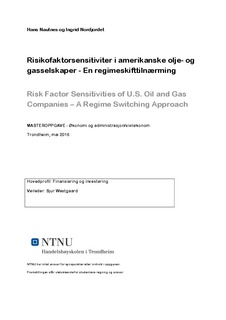| dc.description.abstract | We estimate the excess return of 66 U.S. oil and gas companies’ sensitivities towards risk factors during the period from January 2000 to December 2015. We use the Fama-French 3 factor model augmented with the oil and gas price, an interest rate factor and VIX. Previous studies of the oil and gas industry have found asymmetry in the risk sensitivities. This paper seeks to explain this nonlinear behaviour of stock returns. By using a Markov switching regression to estimate the coefficients of the regression equation, we find that the market, oil price and gas price sensitivities are regime dependent.
The oil price and market risk exposure of U.S. oil and gas companies are positive and significant, however, there are considerable differences in the size of the sensitivities. We find the equipment and services subsector to have the highest risk exposure towards both the market factor and the oil price factor in the high volatility regime. The integrated oil and gas subsector has a dampened exposure towards the oil price in the high volatility regime compared to the low volatility regime. While the exploration and production subsector has a stable exposure towards the price of oil in both regimes. Furthermore, we find that the exploration and production subsector has a higher risk exposure towards the oil factor than integrated oil and gas and the pipeline subsector. The other factors in our model also vary in magnitude, sign and significance, which indicate that the regimes, firms and subsectors are non-homogenous.
The probability of being either in a high or low volatility regime coincides for most part with the business cycle. All though in recent years for oil producing companies, the probability seems to follow the oil price. Integrated oil and gas companies do not follow this trend. This indicates an asymmetric relationship between the business cycle and stock returns in the U.S. oil and gas sector. Our results have implications for hedging and risk management, for decision makers in the industry and both private and institutional investors. We also further contribute to the evidence of asymmetry in risk sensitivities. | |
